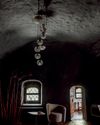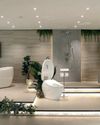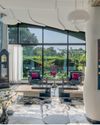Aluminium’s Design Flexibility and Energy Efficiency Makes It a Popular Building Material

The first building to employ aluminium in its construction was the famous New York skyscraper Empire State Building, built in 1931, and the tallest building in the world until 1970. Aluminium was used in all of the building’s basic structures and was widely used in the interior as well. Since then, this metal has changed images of cities and towns. Glass façades of modern buildings are supported by lightweight but sturdy aluminium frames, and most sports facilities use aluminium structures. Besides giving strength, aluminium helps building projects meet Green building standards under the Leadership in Energy and Environmental Design (LEED) programme.
Kushal Bajaj, executive director, Geeta Aluminium (Geeta Group), explains, “Aluminium has always been the first choice with architects and developers due to its strength and flexibility that allows customisation as per needs at a lower cost. It offers most options on its colour-accepting techniques in powder coating, anodizing and PVDF.”
With a rise in the standard of living and earning capacity of people across the country, public demand has paved the way for smart system solutions. Bajaj adds, “At the global level, aluminium caters to the economical range as well as the high-end luxury bracket to satisfy all sections of society with its durability and low maintenance, as compared to other [structural] materials.”
The biggest advantage of aluminium is its lightness – which means high-rises benefit from reduction in the structural load. “The need of the hour is taller and commercial zone buildings, residential buildings, hotels, hospitals, schools, military barracks and, now, affordable housing units. All these require good-quality aluminium glazing systems. Aluminium is an environment-friendly product, and a well-manufactured window or door is a long-term, value-for-money investment,” maintains Karan Keswani, director, Aluplex India.
هذه القصة مأخوذة من طبعة August 2017 من Architect and Interiors India .
ابدأ النسخة التجريبية المجانية من Magzter GOLD لمدة 7 أيام للوصول إلى آلاف القصص المتميزة المنسقة وأكثر من 9,000 مجلة وصحيفة.
بالفعل مشترك ? تسجيل الدخول
هذه القصة مأخوذة من طبعة August 2017 من Architect and Interiors India .
ابدأ النسخة التجريبية المجانية من Magzter GOLD لمدة 7 أيام للوصول إلى آلاف القصص المتميزة المنسقة وأكثر من 9,000 مجلة وصحيفة.
بالفعل مشترك? تسجيل الدخول

REVITALISING HISTORY
The transformation of the Chambers of Khamovnaya Sloboda into a beautiful cultural project is indeed awe-inspiring.

DESIGNING FOR LEARNING
The Basil Woods International School, Hyderabad, designed by Architecture Dialogue is a beautiful example of how design can address the challenges of a site.

THE BATH WAY
New age sanitaryware is all things innovative, design forward, hygienic, and comfortable to make bathrooms functional as well as aesthetic.

BREATHING LIFE
Studio Swatp transforms a historic Alibaug wada into a vibrant holiday retreat.

KNOCKOUT KITCHENS
The kitchen continues to be the heart of modern living spaces, with trends emphasising a seamless blend of innovation, functionality, and aesthetics.

The ROYAL DEN
Harkaran Singh Boparai, Founder and Principal Architect, Harkaran Boparai Studio (HBS), takes us through his regal atelier in the heart of Delhi and the journey that led to it.

SCULPTING FLUIDITY
The architecture of The Liquescent House by Shaili Banker Architects displays a language of organic fluidity.

DESIGN DEBATE NEW IDEAS SET SAIL IN SCENIC GOA
Replete with Portuguese vibes and picturesque sites, the October Edition of the Design Debate held in Goa was an exceptionally intriguing one.

FENESTRATION FOR VILLAS
In contemporary villa architecture, the use of new-age materials in windows and fenestration is driven by the need for durability, sustainability, and sleek design.

BOLD AND ARTISTIC
Bengaluru’s Reservoire introduces a fresh narrative to the city’s social landscape, where art, nature, and architecture converge seamlessly.